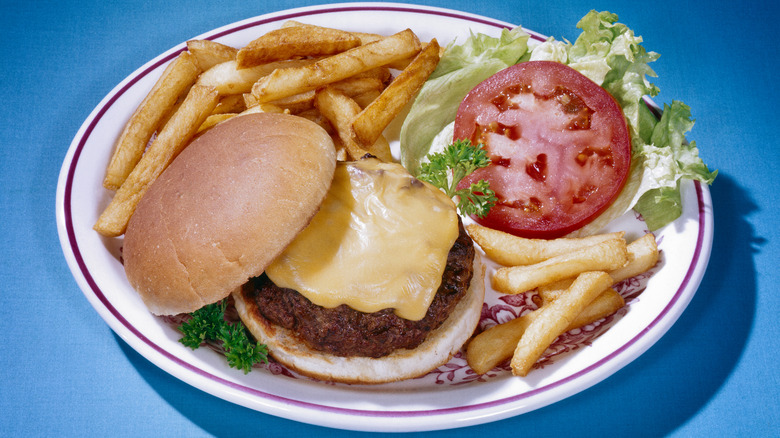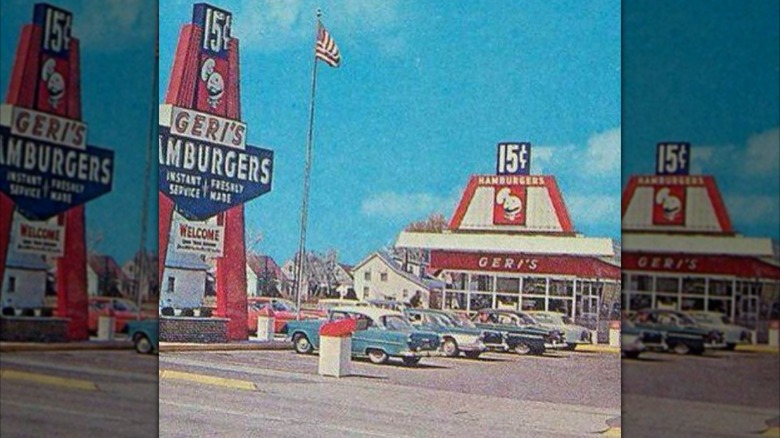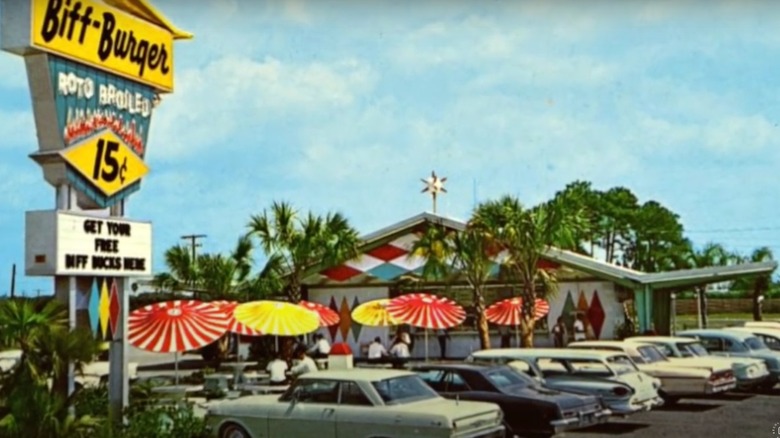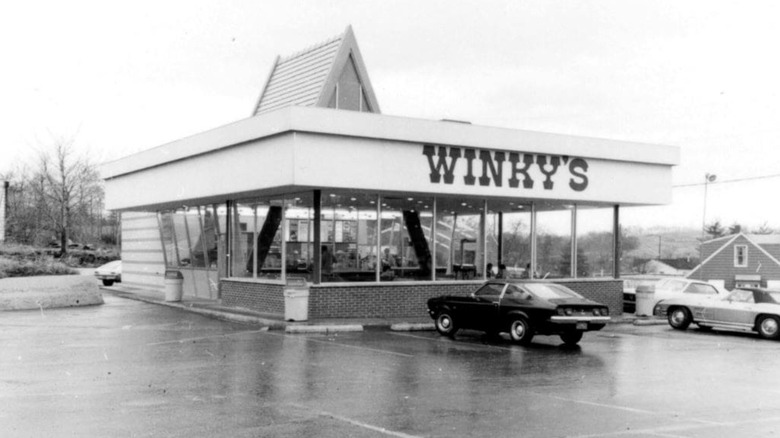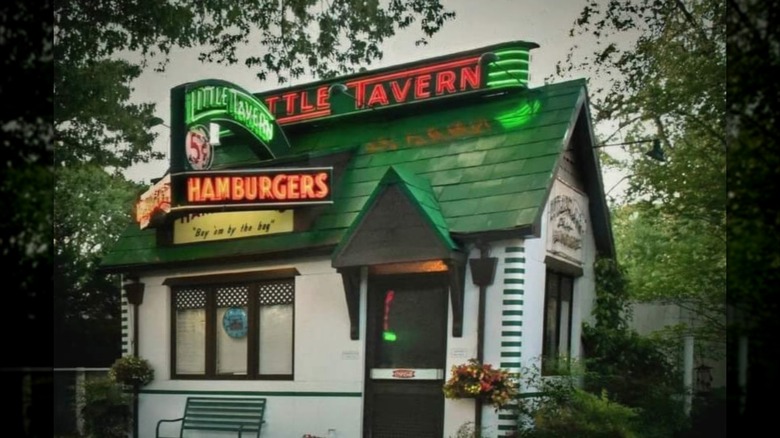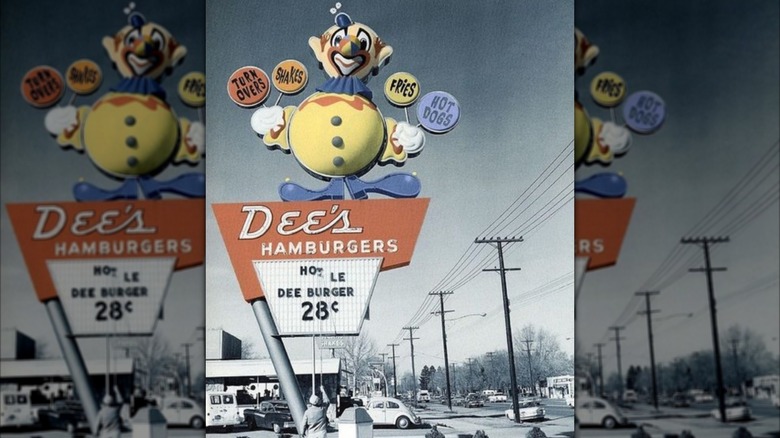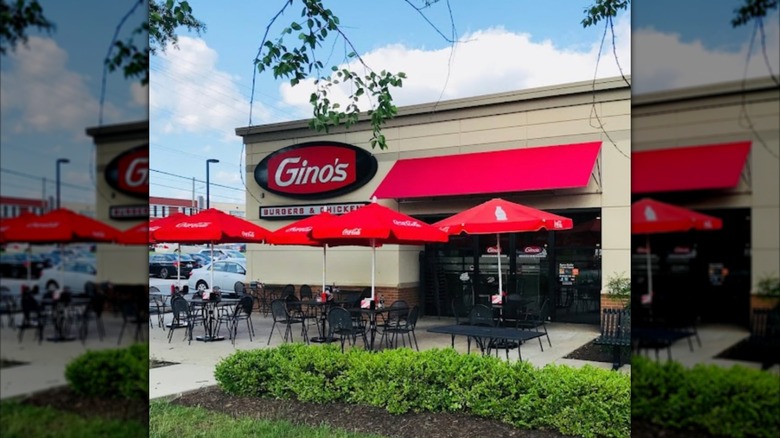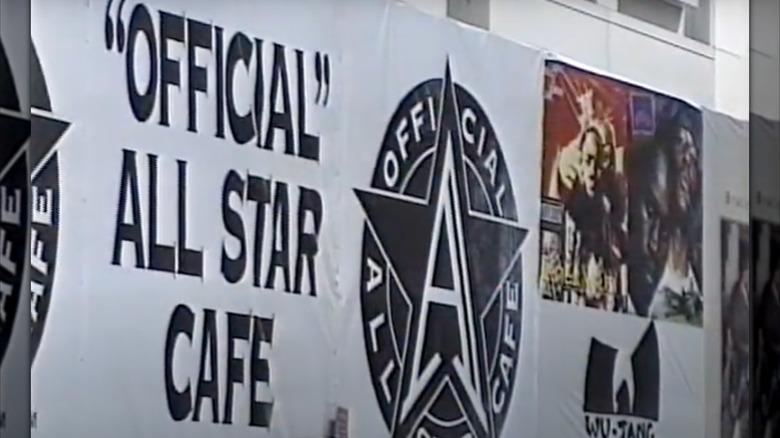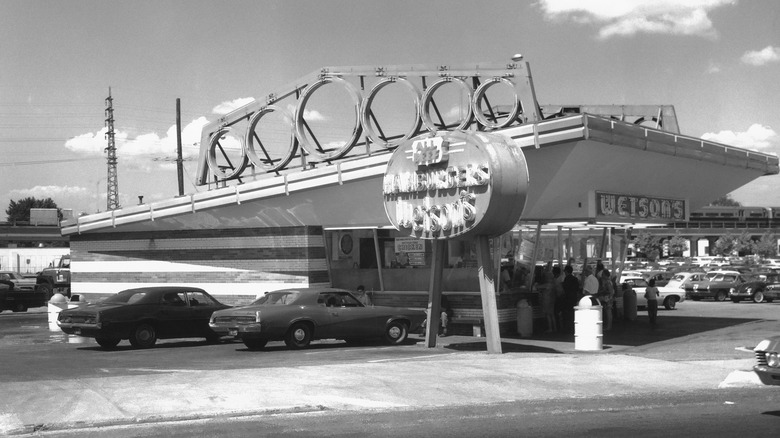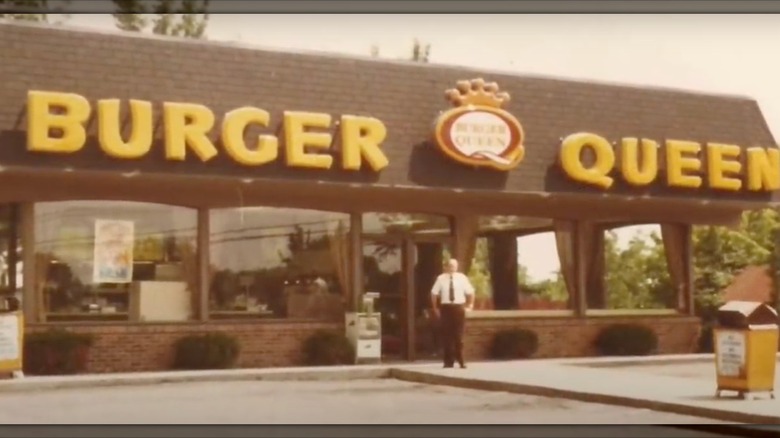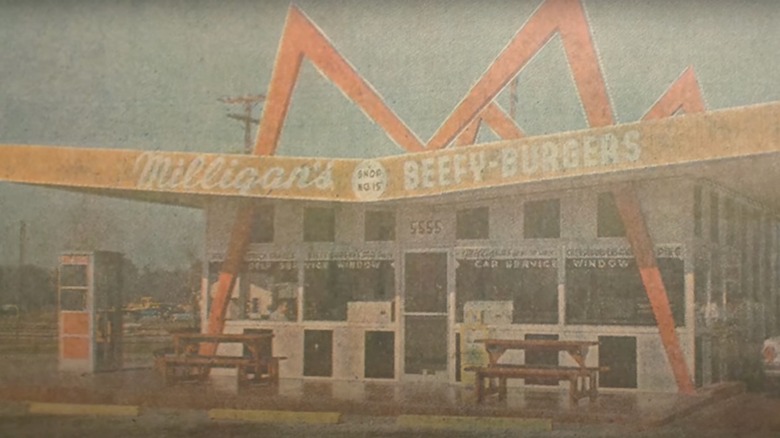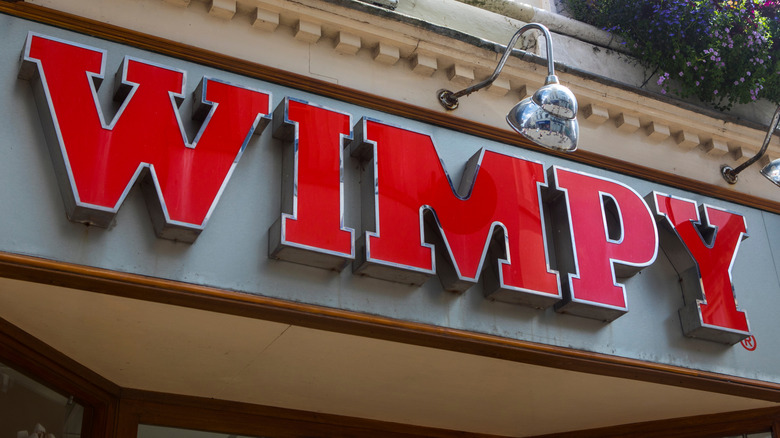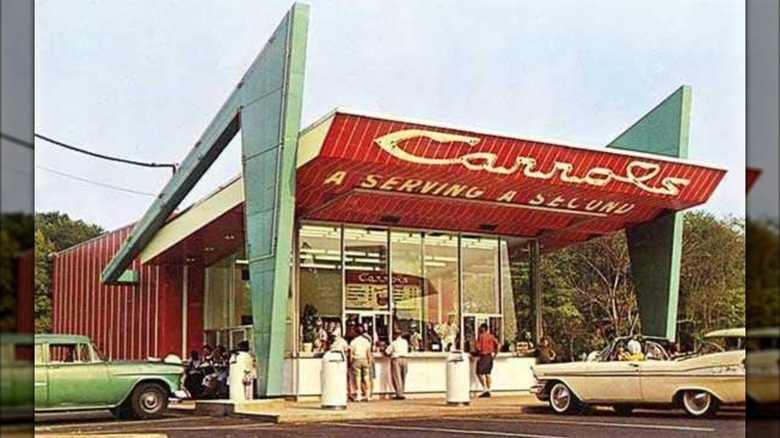14 Vintage Burger Chains That Failed To Make It Nationwide
Generally, you don't have to go far to grab a good burger — from independently owned restaurants to popular chains. Odds are high you'll have a burger franchise in your town: McDonald's, for example, has more than 14,000 restaurants across the United States, while Burger King reported more 7,000 locations in the U.S. and Canada in 2024. With numbers like that, it seems like it's not too challenging to build a great burger chain, right?
While restaurants like McDonald's and Burger King may have continued thriving over many decades, there's countless other vintage chains that fell short of making it nationwide. Of course, some burger franchises achieved local prominence, but there's a big difference between dominating a regional market and a national one. Let's take a trip through the burger chain graveyard, to revisit those restaurants that didn't make it.
Doggie Diner
Contrary to what you might think, Doggie Diner wasn't a restaurant chain that served your pooches. Instead, this vintage franchise was named after one of its flagship products — hot dogs — which it started serving in 1948 in the San Francisco Bay Area, primarily to sailors and nightclub goers who were looking for a quick bite. It wasn't just fast food hot dogs that were on the menu: Burgers were also a key offering at the chain, which held the distinction of being the first fast food restaurant to take hold in post-World War II America.
One of the most notable things about Doggie Diner was how in-tune it was with the importance of publicity and novelty. The owner, Al Ross, had a keen eye on the branding of his restaurant chain, which featured dogs adorned with chef's hats. What started as a single diner eventually grew into a booming business with 30 outlets across San Francisco and the surrounding area — but by the late 1970s the chain was struggling. Doggie Diner was unable to keep up with the giant that was McDonald's, and eventually it shut down for good, never quite pushing out of California.
Geri's Hamburgers
The late 1950s was a big time for one thing in particular: Drive-in restaurants. These were the years where this service style really took off, with McDonald's being one of the early champions of serving food directly to people's cars. While the success of McDonald's is obviously well-known, other burger joints that tried to emulate its success and its drive-in fell short of national dominance. One of them was Geri's Hamburgers, an Illinois-based chain that first opened its doors in 1960 and which went on to have several stores across the state and in Wisconsin.
It's easy to see the influence of McDonald's on Geri's Hamburgers. Geri's put a spin on the famous Golden Arches by erecting a massive red and blue sign outside each store, to indicate to passers-by that they could get their burgers there. Its menu was also pretty simple, offering just hamburgers, fries, shakes, and sodas. Geri's Hamburgers managed to stick it out for a few decades, and there was a moment in 1972 when it looked like it was about to break into the national market. However, it didn't quite stick the landing, and this local favorite eventually closed down its franchising operations in 1981.
Biff-Burger
Say it out loud: Biff-Burger. What does that first word sound like? A bit like "beef," right? This was the not-so-subtle name given to a burger franchise created by brothers Bruce and Earl Brane in 1956. The first Biff-Burger store was founded in Clearwater, Florida, and it served — you guessed it — charbroiled beef burgers that were given a unique twist by being coated in a spicy sauce. As burger chains go, Biff-Burger was far from a flop, and it also got way further than a lot of other places. While some burger franchises fade into obscurity after having just a few locations in one area, Biff-Burger managed to build well over 100 locations across more than a dozen states.
Unfortunately, though, it never quite achieved nationwide prominence. It seems that Biff-Burger was plagued by financial trouble which caused it to seriously struggle by the mid-1970s, leading to all except two of the restaurants closing down. It likely wasn't helped by the fact that it was launched around the same time as McDonald's and Burger King. A few Biff-Burger joints managed to cling well into the 21st century, but by 2021 the last of its restaurants had closed.
Winky's
Winky's is perhaps the burger franchise with the cutest name in history, but underneath that sweet appeal lies a sad story of financial failure. Winky's was founded in February 1962 in Bridgeville, Pennsylvania, and like many other restaurants at the time, it was heavily inspired by McDonald. Indeed, the creators of the restaurant, Harold and Bernard Erenstein, gained crucial knowledge about the layout and operations of McDonald's stores from a nephew who worked at a local branch, and tasked an architect to supply them with designs based on the famous restaurant.
While Winky's started by serving burgers, it eventually began churning out breakfasts and chicken dinners, becoming the first fast food chain to do so. For a while its popularity boomed and it had dozens of locations, but by the mid-1970s it began to face grave cashflow issues exacerbated by local disputes. By 1982 its days were up: Winky's just couldn't keep up with the competition, and it had to file for bankruptcy. It never quite made it out of Pennsylvania.
Little Tavern
As burger franchises go, Little Tavern was arguably the quaintest of them all (even if it's one of those fast food chains that no-one remembers anymore). Each Little Tavern was distinguished by its immediately recognizable store front, which was designed to look like a miniature cottage, complete with a green gabled roof and white walls. The very first Little Tavern was built in 1927 in Louisville, Kentucky, and over the following decades the franchise expanded to encompass more than 50 stores. Its locations were spread across the Baltimore-Washington Metropolitan area, and its offering was simple: Burgers (well, sliders, which you can make at home) sold by the bag, in a similar style to competitor White Castle.
Entering a Little Tavern was kinda like a magic trick. Although the outside looked tiny, the inside of each store was larger than what meets the eye, with the buildings extending far beyond the iconic gabled roof. Although Little Tavern had everything going for it to make it into a nationwide franchise, it seems that it faced too much competition from other slider restaurants. Amazingly, though, it managed to stay in operation for more than 80 years, before the final branch shut its doors in 2008.
Burger Chef
Burger King? How about Burger Chef? If you were living in Indiana in the 1950s, you were likely more of a fan of the latter than the former. Like Burger King, Burger Chef focused on cranking out flame-broiled burgers which had that quintessential balance of smokiness and umami. It seemed like folks couldn't get enough of its patties, and within two years of the first restaurant opening in 1957 in Indianapolis, Burger Chef had more than 40 locations in the Midwest.
In a sense, Burger Chef did make it nationwide, and at one point it had more than 1,200 locations across the country. However, whereas McDonald's and Burger King managed to hold onto its market and achieve true, lasting dominance, Burger Chef's brief success was merely a flash in the pan. In 1968, Burger Chef was sold to General Foods — and once the restaurant was handed over, things started to go downhill. A perfect storm of mismanagement, dwindling appeal, and some fairly tragic events involving the restaurant caused its star to fade, and in 1981 the brand was sold to Hardee's. It may have briefly been everywhere, but Burger Chef didn't quite make it after all — it just never stuck the landing.
Dee's Drive In
You'd be forgiven for thinking that Dee's Drive-In was a single restaurant: After all, the name evokes feelings of a neighborhood joint where you could drive in or walk up and be served by Dee himself. What might surprise you, though, was how big this burger franchise got. After opening its first branch in 1954, Dee's Drive-In racked up more than 50 stores in the space of just a few years. At its peak it was producing more than $20 million per year in sales, which is a lot in today's money, let alone the value of currency back in the 1960s.
It's highly likely that you haven't heard of Dee's Drive-In unless you live in Utah, though. The burger franchise was predominantly located in the state (apart from, strangely, a single restaurant in South Africa), and was destined to be a local attraction as opposed to a national one. Dee F. Anderson, the founder of the chain, didn't just stop at burgers: He also invested in uranium mined in Utah, and later turned his hand to hotel ownership. As for the fate of Dee's Drive-In, it was eventually sold to Hardee's in the late 1970s and disappeared from the map.
Gino's Burgers and Chicken
No prizes for guessing what Gino's Burgers and Chicken used to serve, guys. This chain, more commonly known as just Gino's and formerly called Gino's Hamburgers, was founded in 1957 and was the brainchild of former Baltimore Colt football player Gino Marchetti, along with his business partners Alan Ameche and Joe Campanella. The chain sought to jump on the dual appeal of fried chicken and hamburgers, with the latter taking more of a center stage for a lot of its history.
Gino's was primarily based in Maryland (although it managed to edge into a few other states), but it had a strong foothold on the local market. By the early 1980s there were hundreds of Gino's joints, and the company also operated a couple dozen Kentucky Fried Chicken restaurants and more than 100 Rustler Steak Houses (yet another steak house that time forgot). However, everything changed when Marriott Corp. acquired the brand and began converting its branches into Roy Rogers locations, thereby diluting its presence significantly. Over time, Gino's began to fade into obscurity. In 2011, however, the decision was made to re-ignite the brand by opening a new location in Baltimore County. These days there are two Gino's locations, both in Maryland.
Official All-Star Cafe
If you like your restaurants with a dose of Americana, memorabilia, and good old-fashioned drama, then you'd have loved Official All-Star Cafe. This high-concept burger chain was the epitome of the '90s: Opening its first branch in 1995 in Times Square, the gaudy restaurant had capacity for approximately 650 diners who would eat their burgers surrounded by sports memorabilia and pumping music. Stars like Andre Agassi, Monica Seles, Shaquille O'Neal, and Wayne Gretzky were all roped in to be the faces of the restaurant. Oh, and the amount of burgers you could get there was pretty wild: It served them 51 different ways.
With so much grandeur, you could rightly expect Official All-Star Cafe to make enough money to expand nationwide — and for a time it looked like it was going to, with a branch opening in Las Vegas in 1996 and further locations popping up elsewhere. However, market domination was simply off the cards. While this restaurant chain did manage to dot itself around the country, it never quite made it, and by 2000 it was being sold off after a string of financial troubles.
Wetson's
Anyone who grew up in the 1970s in the Northeast will likely remember the name Wetson's. During that decade the burger chain had more than 70 branches across Connecticut, New Jersey, and New York — impressive considering it first opened in 1959. It was even more impressive when you consider the owners, Herbert and Errol Wetanson, were just 21 and 18 when they started their business. Back then, you could get a hamburger for 15 cents.
Sadly, while Wetson's had its heyday in the early '70s, its days were numbered. It seems that it couldn't keep up with the rapid expansion of other burger chains, especially in built-up metropolitan areas like New York. Wetson's was on its way out by 1975, with branches being sold off to Nathan's Famous. Shortly after this, a merger of the two restaurants was announced and approved, with Nathan's absorbing the Wetson's brand and causing it to evaporate entirely.
Burger Queen
Burger Queen first opened its doors in 1956 in Winter Haven, Florida, just a couple years after Burger King was founded a few hundred miles away in Miami. While you might expect the similarity of the two names to work against Burger Queen (given that Burger King had a meteoric rise), it still saw a lot of success. It soon expanded out of Florida and became one of the biggest franchises in Kentucky, opening its 50th store in the state in 1963.
Burger Queen trucked along for another couple decades, but its attempts to expand internationally were limited by its name's closeness to Burger King. In 1981, it rebranded entirely and began operating under the name Druther's. Although you might think that this was due to competition, apparently the decision was made to more accurately reflect what Burger Queen was serving (as well as, in true American fashion, to get itself a stronger trademark). By that point the restaurant was churning out fish sandwiches, fried chicken, and salads, and it couldn't rightly call itself just a burger chain any more. As the years continued to roll by, Druther's got smaller and smaller, and today there remains just one location in Kentucky.
Milligan's Beefy Burgers
Burger chains may have only really took off around the middle of the 20th century, but before McDonald's and Burger King became iconic, there was Milligan's Beefy Burgers. This iconic Jacksonville restaurant was first founded in 1942, and by the end of the decade there was another location in the city. Soon things started to snowball, and by 1964 there were 16 locations across Florida. Milligan's Beefy Burgers was churning out approximately 5 million sandwiches a year, and its empire continued to grow around the state: In 1966, the Milligan's Center shopping precinct was opened in conjunction with one of its locations.
Milligan's operated with the same model as competitor White Castle, serving multiple small burgers by the sackful at a reasonable price. However, as the 1970s rolled around, the burger chain was facing trouble. Fellow Florida-based chain Burger King was seeing an unstoppable expansion, and Milligan's just couldn't keep up with the dual threat of Burger King and McDonald's. In 1974, Milligan's Beefy Burgers ceased operations, and a Jacksonville institution died.
Wimpy Grill
If you're ever in the United Kingdom, you might see a restaurant chain that was once thriving in the United States — well, locally thriving, anyway. Wimpy, formerly known as Wimpy Grill, is one of those bygone burger chains that sit in shopping centers and gas stations around the British isles, and somehow continues operating. What most British people don't know is that Wimpy Grill started life in Indiana in 1934, with the chain created by Edward V. Gold. Gold is credited with championing the combo of hamburgers and milkshakes which most fast food restaurants still churn out on the regular.
Although Wimpy Grill was founded in Indiana, it was best associated with Chicago, where it had 10 locations by 1940. Wimpy Grill also expanded into other cities around the country and particularly the Midwest, but it never quite became the dominant market force Gold had hoped for. By the time he died in 1977, it had just seven locations in operation. However, Gold was successful in establishing Wimpy Grill's presence internationally, and it continues to sell burgers in the UK and in countries like South Africa, where it's thriving.
Carrols
It's amazing how dominant some burger chains can be in certain areas, even if the rest of the country has never heard of them. A good example of this is Carrols. This burger chain was everywhere in upstate New York and Pennsylvania in the 1960s. It was particularly popular in Rochester, where it managed to have the edge on a fledgling McDonald's, which only had one branch operating in the city. When Carrols was at its most favored, it had approximately 150 outlets churning out burgers daily.
Sadly, though, we all know where this story is going. McDonald's soon started to become the dominant market force in the burger chain space, and Carrols couldn't compete with its sheer size. Burger King was also a big threat for Carrols, and by the time the 1970s rolled around it was flanked on all sides by other burger restaurants. The burger chain never managed to expand across the country and by 1977, there was just one Carrols left standing.
